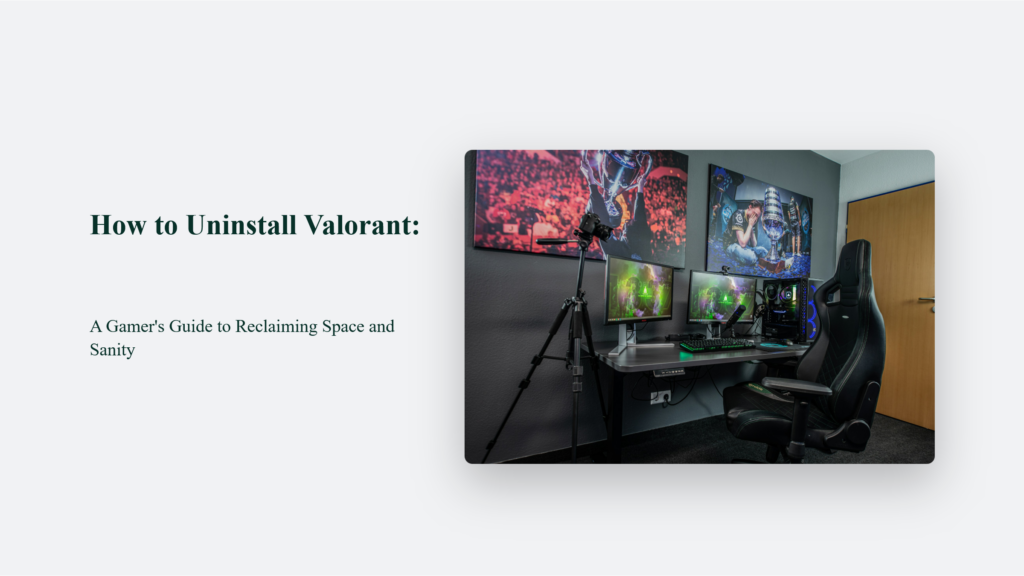In the vast, ever-evolving world of PC gaming, few titles have captured the attention and dedication of players quite like Valorant. Riot Games’ tactical shooter has redefined competitive play and solidified itself as a staple in the gaming community. However, as with any relationship, there comes a time when you need to take a step back, breathe, and even hit the uninstall button.
But how to uninstall Valorant is the real question here.
Whether it’s to clear up some much-needed disk space, troubleshoot persistent issues, or take a break from the game, uninstalling Valorant is a path many gamers find themselves on. But here’s the kicker: Valorant needs to make this breakup easier with its steadfast companion, Vanguard (the anti-cheat software).

Key Takeaways for the Reluctant Uninstaller
- Vanguard First: Always disable Vanguard before attempting to uninstall Valorant. It’s the gatekeeper to your uninstallation journey.
- Follow Through: Ensure you’ve completely removed Valorant and Vanguard from your system. Half measures lead to full frustrations.
- Space and Sanity: Remember, uninstalling isn’t permanent. Valorant will always welcome you back, should you choose to return.
The Whys and the Wise: Uninstalling Valorant
Why would anyone consider uninstalling Valorant, a game that has quickly become a cornerstone of the competitive FPS scene? The reasons are as diverse and complex as the game’s global player base. Let’s delve into the myriad motivations behind this seemingly drastic step, uncovering the layers of decision-making that lead to the uninstallation of such a beloved title.
Seeking Digital Minimalism
In an age where digital clutter can be as overwhelming as its physical counterpart, uninstalling Valorant might simply be a quest for digital minimalism. Players may yearn for a cleaner, more streamlined computer, free from games they no longer play.
It’s about reclaiming precious disk space and decluttering one’s digital life to focus on what truly matters.
Escaping the Competitive Vortex
Valorant’s competitive scene is both exhilarating and, for some, exhaustingly intense. The ranked grind can become a Sisyphean task, with each match adding pressure to perform, achieve, and climb. This stress, compounded over time, can lead some players to seek an escape hatch, finding solace in the simplicity of uninstallation. It’s a digital detox of sorts—a way to step back from the competitive vortex and breathe.
Battling the Toxicity Beast
No online game is immune to toxicity, and Valorant is no exception despite its many charms. Players seeking a healthier gaming environment may step away from the game, disillusioned by encounters with less-than-friendly teammates. It is a move toward preserving one’s mental health and finding joy in gaming without the shadow of negativity.
Troubleshooting: The Last Resort
For others, uninstalling Valorant isn’t a choice but a necessity born out of technical troubles. Whether it’s persistent bugs, performance issues, or conflicts with other software, sometimes the only solution is to start afresh. This troubleshooting step, drastic as it may seem, is a testament to the player’s dedication to a seamless gaming experience—one they hope to reclaim on the other side of reinstallation.
The Pursuit of New Horizons
Gaming, at its core, is about exploration and discovery. Players who uninstall Valorant may simply make room for the next adventure, be it another game or a different hobby. It’s a nod to the transient nature of gaming interests and the ever-present allure of the new and unexplored.
A Strategic Pause
Some players view uninstallation not as a goodbye but as a strategic pause—a deliberate decision to take a break, recalibrate, and perhaps return with renewed vigour. It’s an acknowledgment that sometimes, stepping away is the best way to reignite one’s passion for the game.

How to Uninstall Valorant:
Let’s break down the process of uninstalling Valorant and its anti-cheat software, Vanguard, into simpler steps:
- Turn Off Vanguard: Vanguard is Valorant’s security buddy, always watching for cheats. But before you can remove Valorant, Vanguard needs to take a nap. Find the Vanguard icon near your clock on the taskbar (you might have to click an up arrow to see it), right-click it, and choose “Exit.” It is like telling Vanguard, “It’s time for a break.”
- Uninstall Through Settings: Now that Vanguard is snoozing, press the Windows key on your keyboard (the one with the Windows logo) or click the Windows icon on your taskbar. Type “Add or remove programs” and press Enter. It is like opening the door to all the software you’ve invited to your PC party.
- Find Valorant in the List: Scroll through the installed programs until you find Valorant. It’s like spotting your friend in a crowded room. Click on it, and then you’ll see an “Uninstall” button. Click “Uninstall” to start the process. Your computer might ask if you’re sure about this. It’s like double-checking, “Are you sure you want your friend to leave the party?” If you’re sure, go ahead and confirm.
- Say Goodbye to Vanguard: Don’t forget about Vanguard! You’ll need to find it in the same list (steps 2 and 3) and uninstall it. It’s like ensuring both your friends have left so you can clean up peacefully.
- Check for Leftovers: Sometimes, even after your friends have left, they might leave something behind. So, take a moment to look through your computer for any Valorant or Vanguard files that might still be hanging around. If you find any, you can delete them.
And that’s it! You’ve successfully uninstalled Valorant and Vanguard from your computer, freeing up space for whatever new adventures you decide to embark on next.
In the grand scheme of things, uninstalling Valorant is akin to stepping back from any intense relationship. It’s about reclaiming your space, both digitally and mentally. Whether you’re making room for another game, resolving performance issues, or taking a well-deserved break, remember that uninstallation is not the end. It’s a pause, a breath in the ongoing adventure of gaming. So, here’s to making space – on your hard drive and in your life – for whatever comes next.
Frequently Asked Questions:
How do I uninstall Valorant from my computer?
Begin by disabling Vanguard, Valorant’s anti-cheat system, through the system tray icon. Then, navigate to the Control Panel or Settings > Apps, find Valorant in the list of installed programs, select it, and click on the “Uninstall” button.
Will uninstalling Valorant delete my account or progress?
No, uninstalling the game from your computer does not delete your Valorant account or your progress. All account data and progress are stored on Riot Games’ servers and are tied to your account, not the local game installation.
Can I reinstall Valorant after uninstalling it?
Yes, you can always reinstall Valorant by downloading the installer from the official Valorant website and following the installation process again.




